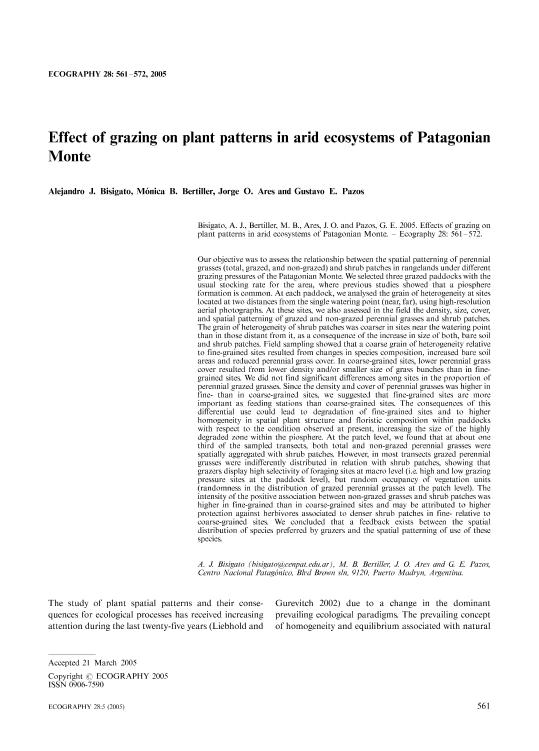Artículo
Effect of grazing on plant patterns in arid ecosystems of Patagonian Monte
Fecha de publicación:
10/2005
Editorial:
Wiley Blackwell Publishing, Inc
Revista:
Ecography
ISSN:
0906-7590
e-ISSN:
1600-0587
Idioma:
Inglés
Tipo de recurso:
Artículo publicado
Clasificación temática:
Resumen
Our objective was to assess the relationship between the spatial patterning of perennial grasses (total, grazed, and non-grazed) and shrub patches in rangelands under different grazing pressures of the Patagonian Monte.We selected three grazed paddocks with the usual stocking rate for the area, where previous studies showed that a piosphere formation is common. At each paddock, we analysed the grain of heterogeneity at sites located at two distances from the single watering point (near, far), using high-resolution aerial photographs. At these sites, we also assessed in the field the density, size, cover, and spatial patterning of grazed and non-grazed perennial grasses and shrub patches. The grain of heterogeneity of shrub patches was coarser in sites near the watering point than in those distant from it, as a consequence of the increase in size of both, bare soil and shrub patches. Field sampling showed that a coarse grain of heterogeneity relative to fine-grained sites resulted from changes in species composition, increased bare soil areas and reduced perennial grass cover. In coarse-grained sites, lower perennial grass cover resulted from lower density and/or smaller size of grass bunches than in fine-grained sites. We did not find significant differences among sites in the proportion of perennial grazed grasses. Since the density and cover of perennial grasses was higher in fine- than in coarse-grained sites, we suggested that fine-grained sites are more important as feeding stations than coarse-grained sites. The consequences of this differential use could lead to degradation of fine-grained sites and to higher homogeneity in spatial plant structure and floristic composition within paddocks with respect to the condition observed at present, increasing the size of the highly degraded zone within the piosphere. At the patch level, we found that at about one third of the sampled transects, both total and non-grazed perennial grasses were spatially aggregated with shrub patches. However, in most transects grazed perennial grasses were indifferently distributed in relation with shrub patches, showing that grazers display high selectivity of foraging sites at macro level (i.e. high and low grazing pressure sites at the paddock level), but random occupancy of vegetation units (randomness in the distribution of grazed perennial grasses at the patch level). The intensity of the positive association between non-grazed grasses and shrub patches was higher in fine-grained than in coarse-grained sites and may be attributed to higher protection against herbivores associated to denser shrub patches in fine- relative to coarse-grained sites. We concluded that a feedback exists between the spatial distribution of species preferred by grazers and the spatial patterning of use of these species.
Palabras clave:
SPATIAL PATTERN
,
SHRUBS
Archivos asociados
Licencia
Identificadores
Colecciones
Articulos(CCT-CENPAT)
Articulos de CTRO.CIENTIFICO TECNOL.CONICET - CENPAT
Articulos de CTRO.CIENTIFICO TECNOL.CONICET - CENPAT
Citación
Bisigato, Alejandro Jorge; Bertiller, Monica Beatriz; Ares, Jorge Oscar; Pazos, Gustavo Enrique; Effect of grazing on plant patterns in arid ecosystems of Patagonian Monte; Wiley Blackwell Publishing, Inc; Ecography; 28; 5; 10-2005; 561-572
Compartir
Altmétricas




